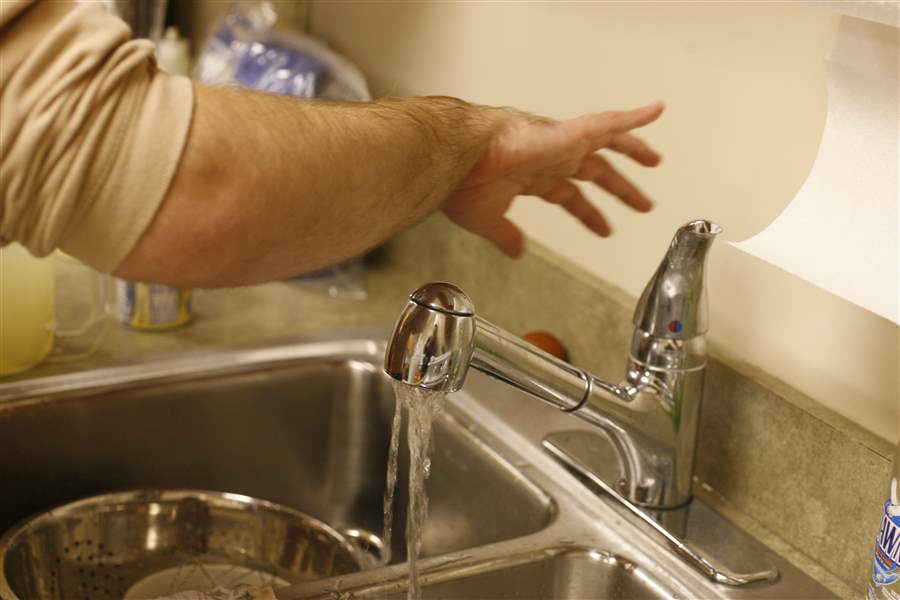
TOLEDO WATER BILLS
Mayor seeks 13.2% a year rate increase
Average household to pay $125 more by 2018
3/23/2013
The Blade
Buy This Image

Bell
Toledo Mayor Mike Bell on Thursday revealed his request for incremental water rate increases over the next five years — a plan that would cost the average household an additional $125 by 2018.
“Some people have said it is not necessarily the best political thing to do but I really don’t care about that,” said Mr. Bell, who is running for re-election this year. “What I do care about is good, running water inside our system.”
The mayor, who revealed the plan during an editorial board meeting at The Blade, said the increases he is asking Toledo City Council to enact are needed to help pay for a long list of repairs and upgrades to the drinking water plant in East Toledo — including a new 40-million gallon redundant treatment unit.
All of the work is mandated by the Ohio Environmental Protection Agency. The plan also includes spending about $10 million a year for the next five years, to replace underground water lines, which, on average, are 72 years old. Without the fixes to the system, Mr. Bell said there would inevitably be a “critical incident” forcing everyone who uses Toledo water to live with a boil advisory.
Related Attachments:
Collins Park Water Treatment Plant 20-year implementation schedule
Toledo Division of Water Treatment Improvement Costs
Toledo proposed water increases 2014-2018
The upgrades will cost $314 million over five years and would be funded through 20 years of bonds financed at just more than 3 percent. The water rate increases would back those bonds, the mayor said.
The mayor stressed the need to consider the dollar amount of each annual increase rather than the percentage of the hikes.
The current monthly rate for 3,000 cubic feet of water, which is about 246 gallons a day, is $14.53.
If Toledo City Council approves Mr. Bell’s plan, that monthly rate would increase 13.2 percent each year starting in 2014 through 2017. It would then increase an additional 4.5 percent in 2018.
Under the plan, the monthly costs would be $16.45 in 2014; $18.62 in 2015; $21.08 in 2016; $23.86 in 2017, and $24.93 in 2018.
The city is at the end of a four-year water rate increase that raised the cost 9 percent each year.
Toledo City Council President Paula Hicks-Hudson said she would keep an open mind about the proposed rate increase, but stopped short of pledging support.
“I think that we have to look at it carefully and within the context of the needs we have to meet,” she said. “I am sure we will have a series of hearings.”
Homeowners pay for at least 2,000 cubic feet of water per quarter, regardless of usage. Additionally, Toledo water department bills include sanitary sewer and storm water sewer charges, and a fixed surcharge to pay for the Toledo Waterways Initiative, a federally mandated sewer upgrade to keep raw sewage out of waterways. Inside city limits, the bill also includes a trash fee.
The 20,000 water customers with a homestead exemption pay less. Their bills are based on using 1,000 cubic feet per quarter, which equals about 82 gallons a day. By 2018, the water cost for those homeowners increases to $18.71 a quarter, up from $10.90 a quarter today.
City Public Utilities Director David Welch said water, sewer, Toledo Waterways Initiative charge, and the trash fee, costs the average household $225 a quarter.
The rates paid by all 500,000 Toledoans and customers in Lucas, Wood, Fulton, and Monroe counties, generate about $46 million a year. That annual revenue will jump to $78 million in 2018 if the rates are increased as the mayor has suggested, Mr. Welch said.
A small number of Lenawee County residents also buy Toledo’s water.
“Half of the revenue comes in from outside the city limits,” Mr. Welch said. “Some of the projects are on hold because the funding is not there. ... The EPA has come in and said you have to do this quicker than you are today ... and the one that has us most concerned is the redundant [system].”
A new 40 million gallon redundant treatment unit, which will cost $96.6 million, is needed to take the system’s 80 million gallon treatment unit offline for repairs. It was built in 1941.
“We can’t shut that plant down without having the redundant. … That is a five to six-year project we have to get up and running,” Mr. Welch said.
The city’s water fund had a reserve of more than $45 million a decade ago, he said. Today, there is about $4.8 million in that fund, Mr. Welch said.
“If we have one catastrophic thing to pay for, it is gone,” he said.
The fund balance was reduced over the years by “kicking the can down the road,” Mr. Bell said.
If council does not approve the increases, the Ohio EPA likely will force the city to increase the rates to make the repairs, said Deputy Mayor Steve Herwat.
“Worst-case scenario, they could engage the Ohio Attorney General to take legal action against the city, forcing us to do this,” Mr. Herwat said. “We met with the Ohio EPA director and his staff in early February to advise them [of] our plans to move forward with the rate increase.”
The Bell administration released a list of 25 projects, of which Mr. Welch said 20 are “critical.”
Last year, the Ohio EPA criticized the city of Toledo’s drinking water treatment plant — warning that the aging facility has operated for years without preventative maintenance, which could lead to a catastrophic failure.
The Ohio EPA called the condition of the plant’s roof above the flocculation and filter buildings a major problem. The city has approved borrowing $15 million for that project.
The other Ohio EPA findings include a lack of reliability because of the age and condition of essential equipment, not enough onsite gaseous chlorine, and inadequate onsite aluminum sulfate storage.
The water treatment facility also has an “obsolete” supervisory control and data acquisition system, the EPA said. That will cost $5 million.
Mr. Herwat said the Ohio EPA sent two teams to review the water treatment plant because of a failure in March, 2012, of the pump station in Jerusalem Township that sends Lake Erie water to the Collins Park plant. A 6-inch solid steel shaft broke and fragments were sucked into two of the four pumps at that facility.
In August, 2011, the low service pump station failed and had to be shut down. It prompted a nearly four-hour race to get the system working before emergency water supplies ran out. If the repairs had taken just a few hours longer or the shutdown had happened in a period of peak water consumption, the drinking water plant could have forced potentially contaminated water into the city’s pipes. If that had happened, 500,000 people in and around Toledo would have been advised to boil water for months until the system was sanitized, Mr. Herwat said.
The city’s plan includes $18.34 million in improvements for the low service pump station.
Mr. Bell’s staff researched water rates for other cities and said they found Toledo is cheaper than Cleveland, Cincinnati, Columbus, Akron, Canton, Detroit, Ann Arbor, and Fort Wayne.
“For a city our size, we are really undercharging from what we have seen as benchmarks from other cities,” Mr. Bell told The Blade.
Contact Ignazio Messina at: imessina@theblade.com or 419-724-6171.